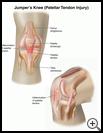
Jumper's Knee (Patellar Tendon Injury)
________________________________________________________________________
KEY POINTS
- Jumper’s knee is pain, inflammation, or a tear in the tendon that connects your kneecap to your shinbone. Tendons are strong bands of tissue that connect muscle to bone.
- You will need to change or stop doing the activities that cause pain until the tendon has healed.
- You may need to wear a special strap, knee brace, or special shoes or shoe inserts while your tendon heals. Your healthcare provider may recommend stretching and strengthening exercises. If your tendon is torn, you may need surgery to repair the tendon.
- Warm-up exercises and stretching before activities and wearing proper shoes can help prevent injuries.
________________________________________________________________________
What is jumper’s knee?
Jumper’s knee is a problem with the tendon that connects your kneecap to your shinbone. Tendons are strong bands of tissue that connect muscle to bone. They can be injured suddenly or they may be slowly damaged over time. You can have tiny or partial tears in your tendon. If you have a complete tear of your tendon, it is called a rupture. Other tendon injuries may be called a strain, tendinosis, or tendonitis. Jumper's knee is also called a patellar tendon injury, or patellar tendinopathy.
What is the cause?
Jumper's knee can be caused by:
- Overuse of the tendon from a sport or work activity that involves your knees, such as too much jumping, running, walking, or bicycling
- A sudden activity that twists or tears your tendon, such as a fall or an accident
Jumper’s knee can also happen if your hips, legs, knees, or feet are not aligned properly. People whose hips are wide, who are knock-kneed, or who have feet with arches that collapse when they walk or run can have this problem.
What are the symptoms?
Symptoms may include:
- Pain and tenderness around your knee and below your kneecap
- Pain when you bend or straighten your leg
- Pain when you jump, run, or walk, especially downhill or down stairs
- Swelling in your knee joint or where your tendon attaches to your shinbone
If your tendon is torn, usually you will have sudden severe pain and you will not be able to straighten your leg or walk.
How is it diagnosed?
Your healthcare provider will examine you and ask about your symptoms, activities, and medical history. Tests may include:
- X-rays
- MRI, which uses a strong magnetic field and radio waves to show detailed pictures of your knee joint.
How is it treated?
You will need to change or stop doing the activities that cause pain until the tendon has healed. For example, swim instead of run.
You may need to wear a special strap that goes over your patellar tendon or a knee brace that helps support and protect your knee while your tendon heals. Special shoes or shoe inserts may also help.
Your healthcare provider may give you a shot of a steroid medicine or shots of protein-rich plasma to help you return to your sport more quickly. Your provider may recommend stretching and strengthening exercises to help you heal.
If your tendon is torn, you may need surgery to repair the tendon.
The pain often gets better within a few weeks with self-care, but some injuries may take several months or longer to heal. It’s important to follow all of your healthcare provider’s instructions.
How can I take care of myself?
To help the swelling and pain:
- Put an ice pack, gel pack, or package of frozen vegetables wrapped in a cloth, on the area every 3 to 4 hours for up to 20 minutes at a time.
- Keep your knee up on a pillow when you sit or lie down.
- Take nonprescription pain medicine, such as acetaminophen, ibuprofen, or naproxen. Read the label and take as directed. Unless recommended by your healthcare provider, you should not take these medicines for more than 10 days.
- Nonsteroidal anti-inflammatory medicines (NSAIDs), such as ibuprofen, naproxen, and aspirin, may cause stomach bleeding and other problems. These risks increase with age.
- Acetaminophen may cause liver damage or other problems. Unless recommended by your provider, don't take more than 3000 milligrams (mg) in 24 hours. To make sure you don’t take too much, check other medicines you take to see if they also contain acetaminophen. Ask your provider if you need to avoid drinking alcohol while taking this medicine.
Follow your healthcare provider's instructions, including any exercises recommended by your provider. Ask your provider:
- How and when you will get your test results
- How long it will take to recover
- If there are activities you should avoid, including how much you can lift, and when you can return to your normal activities
- How to take care of yourself at home
- What symptoms or problems you should watch for and what to do if you have them
Make sure you know when you should come back for a checkup. Keep all appointments for provider visits or tests.
How can I help prevent jumper’s knee?
Warm-up exercises and stretching before activities can help prevent injuries. For example, do stretches and exercises that strengthen your thigh muscles. If your knee hurts after exercise, putting ice on it may help keep it from getting injured.
Follow the safety rules for your work or sport and use protective equipment, like wearing the right type of shoes for your activities.

